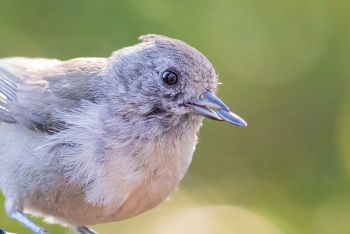(→External Links: New combined GSearch. GSearch checked template) |
|||
| (12 intermediate revisions by 6 users not shown) | |||
| Line 1: | Line 1: | ||
| − | + | [[File:Oak_Titmouse2.jpg|thumb|550px|right|<br />Photo © by {{user|Doug+Greenberg|Doug Greenberg}}<br />Berkeley, [[California]], [[USA]], 31 December 2006]] | |
| − | [[ | + | ;[[:Category:Baeolophus|Baeolophus]] inornatus |
==Identification== | ==Identification== | ||
| − | + | L. 5.75 in | |
| + | *Brown-tinged | ||
| + | *Plain face | ||
| + | *Short crest | ||
| − | |||
| − | |||
| − | |||
==Distribution== | ==Distribution== | ||
| − | + | [[File:Oak_Titmouse_Detail_CONNR.jpg|thumb|350px|right|Detail Reference<br />Photo © by {{user|connorco|connorco}}<br />Marin County, [[California]], [[USA]], 21 May 2021]] | |
| + | [[United States]] and [[Mexico]]. | ||
==Taxonomy== | ==Taxonomy== | ||
| + | Until recently, '''Oak Titmouse''' and [[Juniper Titmouse]] were considered parts of the same species called Plain Titmouse, ''Baeolophus inornatus''. Because the Oak Titmouse inherited the scientific name from the parent species, there can be problems with which exact species is found using the gallery search below. There have been further proposals to split the subspecies ''cineraceus'' from Oak Titmouse into its own species which would then be called Cape Titmouse and be resident in Baja California. | ||
| + | |||
| + | ====Subspecies==== | ||
| + | Four subspecies are recognized<sup>[[#References|[1]]]</sup>: | ||
| + | *''B. i. inornatus''<br /> | ||
| + | South-western [[Oregon]] and northern [[California]] south to southern California (Santa Barbara and Kern counties)<br /> | ||
| + | *''B. i. affabilis''<br /> | ||
| + | Southwestern California (Ventura County) to northern [[Baja California]]<br /> | ||
| + | *''B. i. mohavensis''<br /> | ||
| + | Little San Bernardino Mountains of southern California<br /> | ||
| + | *''B. i. cineraceus''<br /> | ||
| + | Cape district of southern Baja California<br /> | ||
==Habitat== | ==Habitat== | ||
| − | + | Open oak and pine-oak woodlands. | |
==Behaviour== | ==Behaviour== | ||
| − | The | + | ====Breeding==== |
| + | The female builds nest with grass, moss, feathers, shredded bark in tree cavities. Incubation is 14 to 16 days, and young fledge in about 17 days. | ||
| + | ====Diet==== | ||
| + | Diet includes seeds, mostly from oaks, and a variety of invertebrates including leafhoppers and treehoppers. | ||
| − | + | ==References== | |
| + | #{{Ref-Clements6thAug19}} | ||
| + | {{ref}} | ||
| + | ==External Links== | ||
| + | {{GSearch|"Baeolophus inornatus" {{!}} "Oak Titmouse"}} | ||
| + | {{GS-checked}}1 | ||
| + | <br /> | ||
| + | <br /> | ||
| − | + | [[Category:Birds]] [[Category:Baeolophus]] | |
| − | |||
| − | [[Category: | ||
Latest revision as of 20:23, 8 April 2023
- Baeolophus inornatus
Identification
L. 5.75 in
- Brown-tinged
- Plain face
- Short crest
Distribution
United States and Mexico.
Taxonomy
Until recently, Oak Titmouse and Juniper Titmouse were considered parts of the same species called Plain Titmouse, Baeolophus inornatus. Because the Oak Titmouse inherited the scientific name from the parent species, there can be problems with which exact species is found using the gallery search below. There have been further proposals to split the subspecies cineraceus from Oak Titmouse into its own species which would then be called Cape Titmouse and be resident in Baja California.
Subspecies
Four subspecies are recognized[1]:
- B. i. inornatus
South-western Oregon and northern California south to southern California (Santa Barbara and Kern counties)
- B. i. affabilis
Southwestern California (Ventura County) to northern Baja California
- B. i. mohavensis
Little San Bernardino Mountains of southern California
- B. i. cineraceus
Cape district of southern Baja California
Habitat
Open oak and pine-oak woodlands.
Behaviour
Breeding
The female builds nest with grass, moss, feathers, shredded bark in tree cavities. Incubation is 14 to 16 days, and young fledge in about 17 days.
Diet
Diet includes seeds, mostly from oaks, and a variety of invertebrates including leafhoppers and treehoppers.
References
- Clements, J. F., T. S. Schulenberg, M. J. Iliff, S. M. Billerman, T. A. Fredericks, B. L. Sullivan, and C. L. Wood. 2019. The eBird/Clements Checklist of Birds of the World: v2019. Downloaded from http://www.birds.cornell.edu/clementschecklist/download/
Recommended Citation
- BirdForum Opus contributors. (2025) Oak Titmouse. In: BirdForum, the forum for wild birds and birding. Retrieved 15 May 2025 from https://www.birdforum.net/opus/Oak_Titmouse
External Links
GSearch checked for 2020 platform.1





